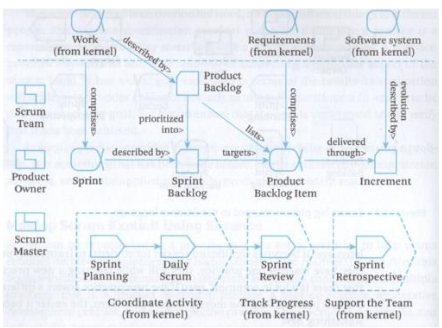Representación de algunos principios del Manifiesto Ágil en el núcleo de la Esencia de Semat
DOI:
https://doi.org/10.22517/23447214.24241Resumen
El Manifiesto Ágil tiene un conjunto de principios que guían el desarrollo ágil de software, el cual se presenta como una alternativa a los procesos de desarrollo tradicionales. En la
revisión de la literatura hay varios intentos para tratar de adaptar diferentes procesos en contextos ágiles, pero esta adaptación se dificulta debido a que no existe una representación del Manifiesto Ágil en un terreno común y, además, la interpretación de esos principios puede tener subjetividad. El núcleo de Semat (Software Engineering Method and Theory) tiene un terreno común para representar cualquier esfuerzo de ingeniería de software. En este artículo se representan algunos principios del Manifiesto Ágil en un terreno común usando el lenguaje que provee el núcleo de la Esencia de Semat. Además, se introduce el manejo del tiempo en la representación de dicho núcleo mediante el lenguaje OCL (Object
Constraint Language). La representación de los principios del Manifiesto Ágil en un terreno común permitirá adaptar y evaluar diferentes procesos en contextos ágiles.
Descargas
Citas
[1] A. Singh, K. Singh, and N. Sharma, “Agile knowledge management: a
survey of Indian perceptions,” Innov. Syst. Softw. Eng., vol. 10, no. 4, pp. 297–315, 2014. DOI: https://doi.org/10.1007/s11334-014-0237-z
[2] M. Kaisti, T. Mujunen, T. Mäkilä, V. Rantala, and T. Lehtonen, “Agile principles in the embedded system development,” Agile Processes in Software Engineering and Extreme Programming, vol. 179, G. Cantone and M. Marchesi, Eds. Rome: Springer, 2014, pp. 16–31. DOI: https://doi.org/10.1007/978-3-319-06862-6_2
[3] I. F. Da Silva, P. A. da Mota Silveira Neto, P. O’Leary, E. S. de Almeida,
and S. R. de Lemos Meira, “Using a Multi-Method Approach to Understand Agile Software Product Lines,” Inf. Softw. Technol., vol. 57, no. 1, pp. 527–542, 2014. DOI:
https://doi.org/10.1016/j.infsof.2014.06.004
[4] R. Popli, R. Anita, and N. Chauhan, “A mapping model for trans-forming
traditional software development methods to agile-methodology,” Int. J.
Softw. Eng. Appl., vol. 4, no. 4, pp. 53–64, 2013. DOI: https://doi.org/10.5121/ijsea.2013.4405
[5] I. Jacobson, P. Ng, P. E. Mcmahon, and C. (Traductor) Zapata, “La Esencia de la Ingeniería de Software: El Núcleo de Semat,” Rev. Latinoam. Ing. Softw, vol. 1, no. 3, pp. 71–78, 2013. DOI: https://doi.org/10.18294/relais.2013.71-78
[6] M. Fowler and J. Highsmith, “The agile manifesto,” Softw. Dev., vol. 9, no. 8, pp. 28–35, 2001.
[7] Object Management Group, “Essence–Kernel and Language for Software
Engineering Methods, version 1.2,” 2018.
[8] B. Kanso and S. Tala, “Temporal constraint support for OCL.” In International Conference on Software Language Engineering, pp. 83–103, 2012. DOI: https://doi.org/10.1007/978-3-642-36089-3_6
[9] I. Jacobson, H. Lawson, P.-W. Ng, P. McMahon, and M. Goedicke. The
essentials of modern software engineering: free the practices from the method prisons!,” Milton Keynes, UK: ACM Books, 2019. DOI: https://doi.org/10.1145/3277669.3277673
[10] M. González-Pérez, C. M. Zapata-Jaramillo, L. González-Palacio. “Toward a standardized representation of RUP best practices of project management in the Semat kernel,” in Software engineering: methods, modeling, and teaching, vol. 3, chapter 7, Zapata, C. M. & Castro, L. (Ed.). Medellín, Colombia: Universidad Nacional de Colombia, 2014.
[11] Rational. “Rational Unified Process: Best Practices for Software Development Teams” Rational Software White Paper TP026B, 1998.

Publicado
Cómo citar
Número
Sección
Licencia
Derechos de autor 2023 Scientia et technica

Esta obra está bajo una licencia internacional Creative Commons Atribución-NoComercial-CompartirIgual 4.0.
Derechos de autor y licencias
La revista es de acceso abierto gratuito y sus artículos se publican bajo la licencia Creative Commons Atribución/Reconocimiento-No Comercial-Compartir bajo los mismos términos 4.0 Internacional — CC BY-NC-SA 4.0.
Los autores de un artículo aceptado para publicación cederán la totalidad de los derechos patrimoniales a la Universidad Tecnológica de Pereira de manera gratuita, teniendo en cuenta lo siguiente: En caso de que el trabajo presentado sea aprobado para su publicación, los autores deben autorizar de manera ilimitada en el tiempo, a la revista para que pueda reproducirlo, editarlo, distribuirlo, exhibirlo y comunicarlo en cualquier lugar, ya sea por medios impresos, electrónicos, bases de datos, repositorios, discos ópticos, Internet o cualquier otro medio requerido.
Los cedentes mediante contrato CESIÓN DE DERECHOS PATRIMONIALES declaran que todo el material que forma parte del artículo está totalmente libre de derechos de autor de terceros y, por lo tanto, se hacen responsables de cualquier litigio o reclamación relacionada o reclamación relacionada con derechos de propiedad intelectual, exonerando de toda responsabilidad a la Universidad Tecnológica de Pereira (entidad editora) y a su revista Scientia et Technica. De igual forma, los autores aceptan que el trabajo que se presenta sea distribuido en acceso abierto gratuito, resguardando los derechos de autor bajo la licencia Creative Commons Atribución/Reconocimiento-No Comercial- Compartir bajo los mismos términos 4.0 Internacional — CC BY-NC-SA 4.0.
https://creativecommons.org/licenses/by-nc-sa/4.0/
A los autores, la revista Scientia et Technica tiene la obligación de respetarle los derechos morales (artículo 30 de la Ley 23 de 1982 del Gobierno Colombiano) que se les debe reconocen a estos la paternidad de la obra, el derecho a la integridad y el derecho de divulgación. Estos no se pueden ceder ni renunciar.


